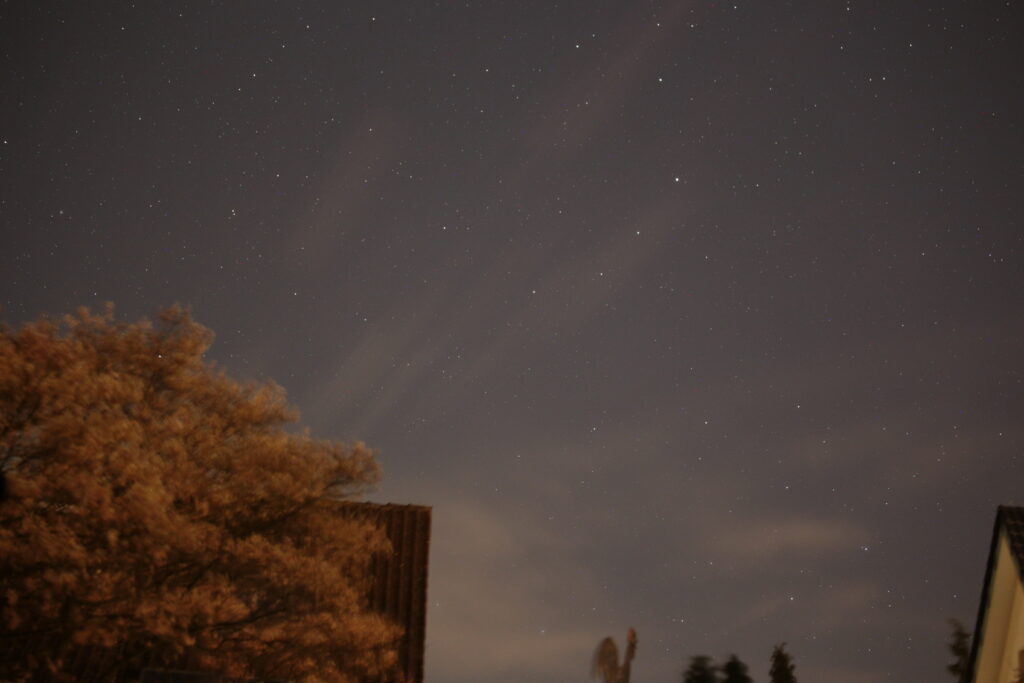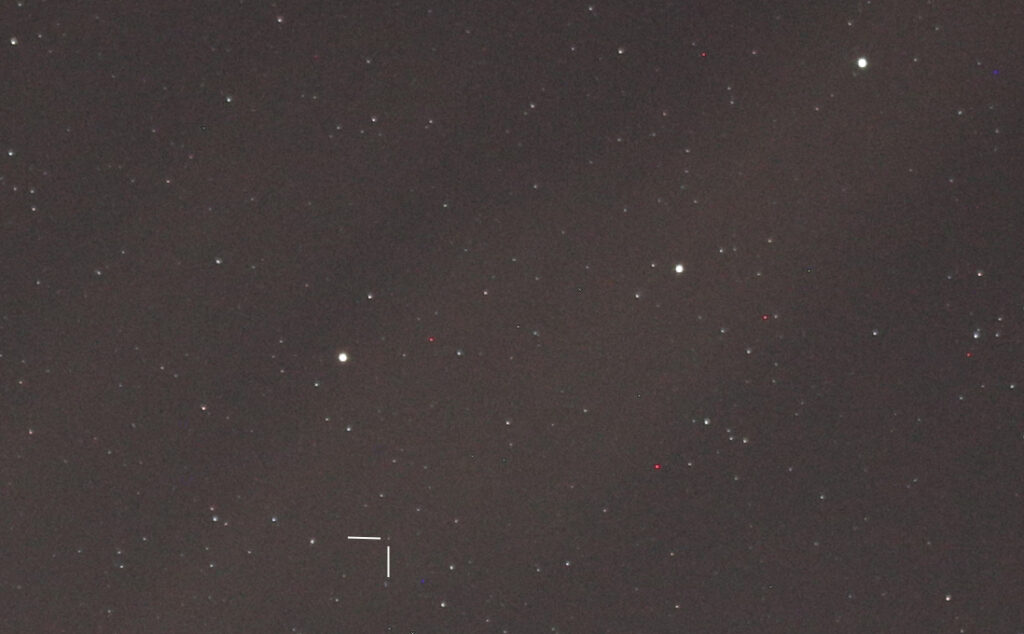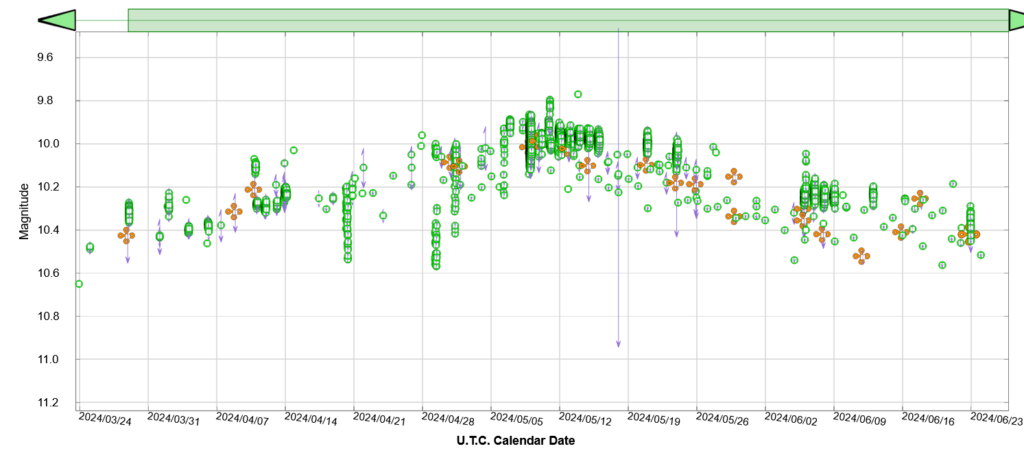May 15, 2024, Dr. Gerold Holtkamp
June 24, 2024, update
A star in the constellation Northern Crown is described, for which a drastic increase in brightness is expected this year 2024. The historical events of this nova are discussed, especially the current state of knowledge about this star, which lights up regularly about every 80 years. The observation and measurement options available today's amateur astronomers are also used in Osnabrück.
First of all, a disappointment: A nova is not a new star, as the name might suggest. The term arose many centuries ago when a star that was invisible to the naked eye suddenly became several magnitudes brighter and therefore visible. Every now and then “new” stars “appeared” that were not visible before. The term Nova is therefore historically determined.
The nova in the Northern Crown, T CrB *, which we are waiting for when this article is published, was - as already mentioned above - also observed in earlier centuries. Abbot Burkhard von Upsberg had already described it in 1217 as a star that shone brightly for several days. In 1866 and 1946 it reached a brightness of 2 mag [1]. The Polar Star, for example, is that bright. If it happens this year, the crown will then look different for a few days. In addition to the 2.3 mag bright Gemma, there will then be a bright “point” or – as more poetic spirits would say – a “new gemstone” in the crown.

Despite light pollution and veiled clouds, the “Northern Crown” can be easily seen with a camera. Only the brightest star, Gemma, could be seen with the naked eye.

In this enlarged detail (the bottom three bright stars of the crown are still visible) of this simple image, you can even see the star T CrB. We live in happy times for amateur astronomers!
The current level of knowledge differs significantly from that of Abbot Burkhard von Upsberg. Science has replaced superstition (“a wonderful sign”) with measurement and modeling [1]. T CrB is located about 2,700 light-years away from us and is a so-called cataclysmically variable star. It is a binary star system in which a white dwarf and a red giant orbit each other closely. The two stars orbit each other every 228 days. The orbit is almost circular and is at an angle of 67° to us on Earth. The stars are about 80 million km apart. This is very close for stars, so matter is constantly flowing from the red giant to the surface of the white dwarf. When the amount of matter has increased sufficiently, an explosive nuclear fusion occurs, which manifests itself as a nova for us on Earth. With T CrB this occurs at regular intervals of around 80 years. Even if there is not much reliable historical evidence of these outbreaks, this frequency is assumed to be relatively certain.

During the last burst of T CrB, the light curve at AAVSO (American Association of Variable Star Observers), visually observed by many amateurs, looked like this. So you have to be very careful not to miss the event. The T CrB flare will obviously only last for a few days. Just like here in Osnabrück, there is huge interest among astronomers worldwide. For example, the number of active observers of T CrB at AAVSO has grown from 120 in 2022 to 160 in 2024 [3].
In 1946, amateurs could only estimate the brightness of a star visually, but today we have highly sensitive cameras at our disposal.
The author takes measurements in Osnabrück with a Canon 6D, a single-lens reflex camera (DSLR), either with a 300 mm F/5 lens on a Star Adventurer travel tracker or with a Skywatcher APO 80/600 telescope on a Skywatcher mount AZ EQ6 Pro. The former, simple structure was chosen so that, given the very changeable weather in our region with often cloudy skies, we can react quickly and also enable measurements when only gaps in the clouds allow a view of the stars.
Der Kollege Dr. Thomas Kunzemann misst in Preussisch-Oldendorf mit einem Teleskop Explore Scientific ED 80, mit 480mm Brennweite und einer DSLR-Kamera Canon R_15s.
Typically 20 images are taken of T CrB and its surrounding star field. The DSLR only reads the green channel, which is comparable to the V Sloan channel. The photometry is done with MuniWin. The average is calculated from the values obtained and the error is determined. It is relative photometry, i.e. the measured brightness of T CrB is normalized with that of a known reference star. The result will be published shortly after the above mentioned. Database submitted to AAVSO.

* Naming variable stars
https://de.m.wikipedia.org/wiki/Benennung_ver%C3%A4nderlicher_Sterne
______________________________________________________________________
[1] The recurrent nova T CrB had prior eruptions observed near December 1787 and October 1217 AD, Bradley E. Schaefer, Journal for the History of Astronomy, 2023, vol. 54, pp. 436-455, https://arxiv.org/abs/2308.13668
[2] Datenbank der American Association of Variable Star Observers (AAVSO), ausgelesen am 8.5.2024
[3] The Jewel in the Crown, Tim Lyster, AAVSO homepage, read on May 8, 2024 (The author also mentions that the number of observations in 2022 increased from 5,020 to 26,360 compared to 2024. However, the caveat should apply here that some amateurs submitted an unnecessary number of individual measurements for one point in time and thus inflated the number.)